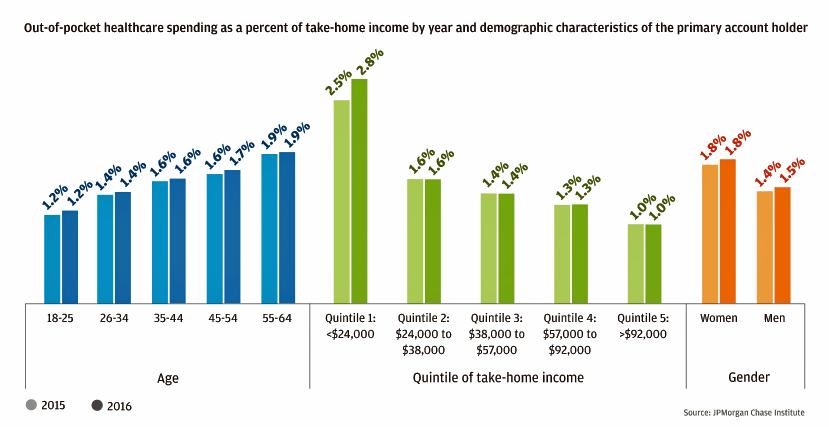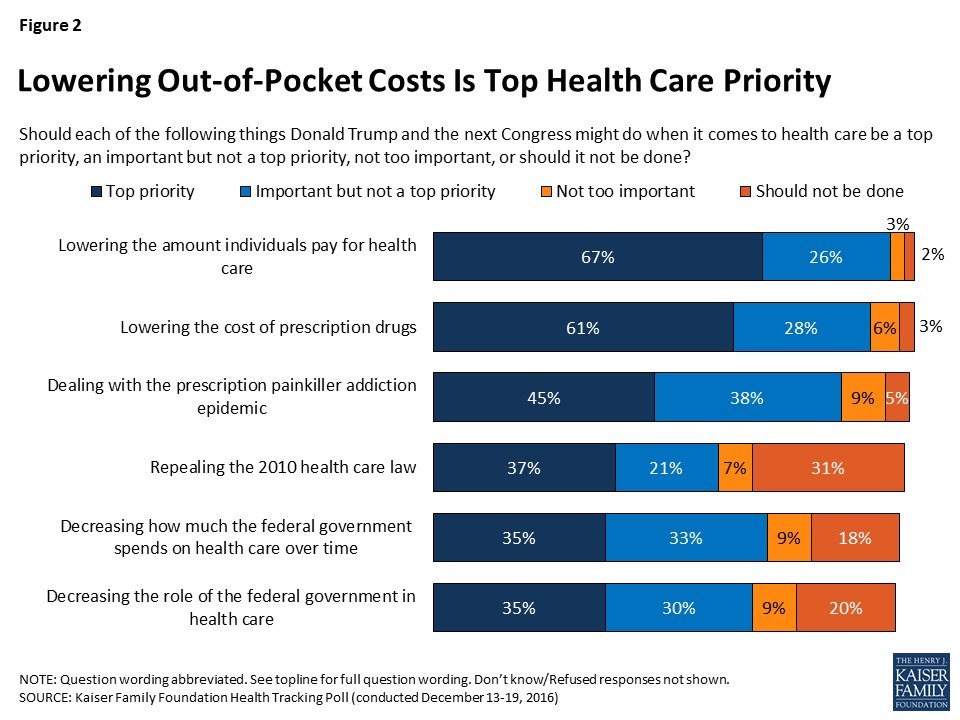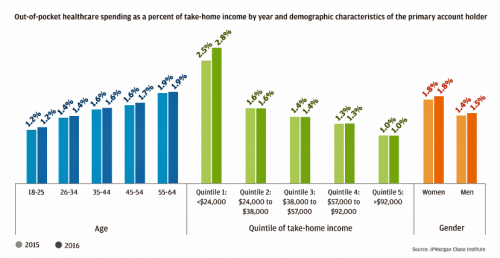 For each dollar spent on healthcare in the United States, families paid 28 cents, according to the U.S. National Health Expenditure Accounts for 2015. Welcome to the new era of Americans and medical banking, with new insights provided by the largest of banks, JP Morgan Chase, in Paying Out-of-Pocket: The Healthcare Spending of 2 Million U.S. Families, from JP Morgan Chase.
For each dollar spent on healthcare in the United States, families paid 28 cents, according to the U.S. National Health Expenditure Accounts for 2015. Welcome to the new era of Americans and medical banking, with new insights provided by the largest of banks, JP Morgan Chase, in Paying Out-of-Pocket: The Healthcare Spending of 2 Million U.S. Families, from JP Morgan Chase.
Chase is the largest bank in America based on its assets. They’ve mined 2.3 million de-identified records of Chase consumers in their banking network to learn about customers’ healthcare spending. These data represent spending between 2013 and 2016, detailed in this report. Consumers were between 18 and 64 years of age, and therefore do not include people enrolled in Medicare.
 In 2016, out-of-pocket costs (OOPs) for Chase customers reached $714, growing by 4.3% year-on-year between 2013 and 2016.
In 2016, out-of-pocket costs (OOPs) for Chase customers reached $714, growing by 4.3% year-on-year between 2013 and 2016.
The second chart illustrates OOP spending differences between different demographic groups. Note that women have greater OOP spending than men, very low income people more than more affluent consumers, and older versus younger people.
Women’s OOP expenses were 20% greater than men’s as a percent of take-home income in 2016.
Most OOP spending was for doctor, dental and hospital payments which accounted for over one-half of the observed healthcare spending. The largest single OOP healthcare expense, on average, was for dental care.
The top 10% of families with the greatest OOPs accounted for 49% of all OOP spending. This spending averaged 9% of family take-home income, and about one-half of these families spent another 9% of income the following year. This 9% is how much one family spends on cell phone and utility bills in one year, Chase calculated.
 Health Populi’s Hot Points: Chase concludes that health care reform it he U.S. should recognize that out of pocket spending is a strain for American families and reforms should account for this situation for those households who are more financially burdened. These are older, lower-income, and female health citizens.
Health Populi’s Hot Points: Chase concludes that health care reform it he U.S. should recognize that out of pocket spending is a strain for American families and reforms should account for this situation for those households who are more financially burdened. These are older, lower-income, and female health citizens.
Chase isn’t the only entity who believes out-of-pocket costs should be a health reform priority. So do 93% of American adults, polled in last December’s Kaiser Family Foundation Health Tracking Poll, who called it a top or important priority to “lower the amount individuals pay for healthcare.” Nearly as many Americans said lowering the cost of prescription drugs was the next highest priority for health reform — specifically, for “things Donald Trump and the next Congress might do when it comes to health care.”





 Interviewed live on BNN Bloomberg (Canada) on the market for GLP-1 drugs for weight loss and their impact on both the health care system and consumer goods and services -- notably, food, nutrition, retail health, gyms, and other sectors.
Interviewed live on BNN Bloomberg (Canada) on the market for GLP-1 drugs for weight loss and their impact on both the health care system and consumer goods and services -- notably, food, nutrition, retail health, gyms, and other sectors. Thank you, Feedspot, for
Thank you, Feedspot, for  As you may know, I have been splitting work- and living-time between the U.S. and the E.U., most recently living in and working from Brussels. In the month of September 2024, I'll be splitting time between London and other parts of the U.K., and Italy where I'll be working with clients on consumer health, self-care and home care focused on food-as-medicine, digital health, business and scenario planning for the future...
As you may know, I have been splitting work- and living-time between the U.S. and the E.U., most recently living in and working from Brussels. In the month of September 2024, I'll be splitting time between London and other parts of the U.K., and Italy where I'll be working with clients on consumer health, self-care and home care focused on food-as-medicine, digital health, business and scenario planning for the future...